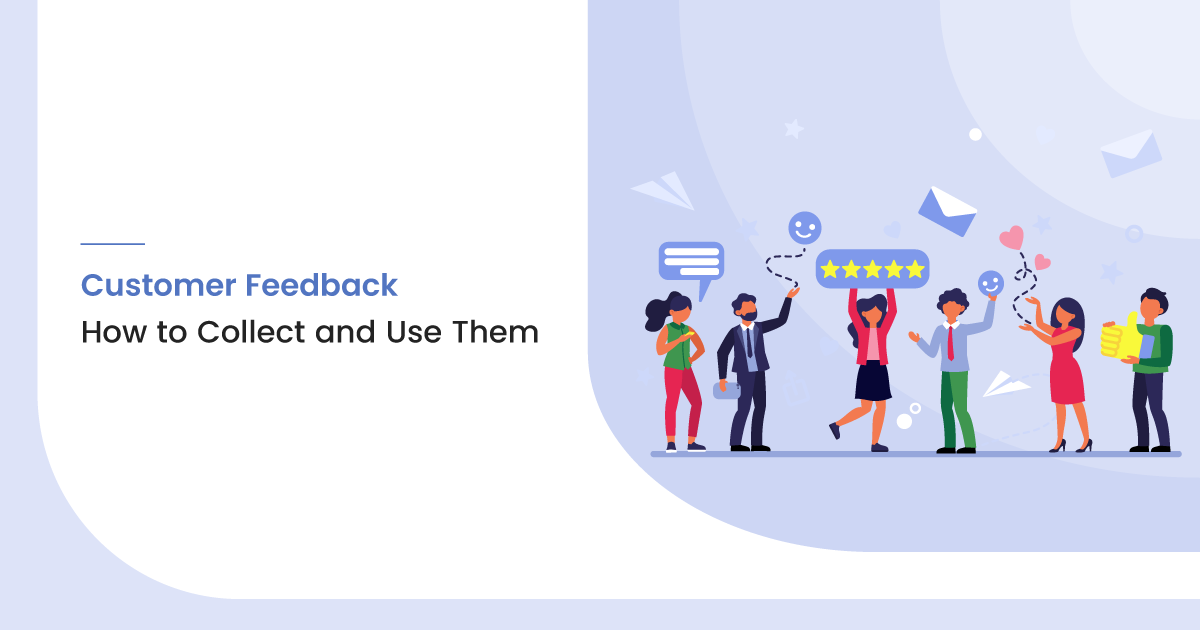Reading Time: 6 minutes
Feedback is an essential tool that helps us all know how we are doing and how we can improve. For businesses, too, it is a key tool to understanding whether your customers are happy with your product or service or not. This helps them improve their services and serve customers better.
A whopping 52% of customers globally believe that companies need to act on the feedback given. For consumers, a company that works on their feedback can easily earn their loyalty. On the other hand, organizations that don’t improve themselves in spite of repeated feedback lose their customers swiftly.
There are different types of feedback that help evaluate different metrics. Analyzing these metrics can improve or enhance brand image, product reputation, customer satisfaction, and much more.
This blog will dig deep into the types of customer feedback and how you can collect them and use them for your benefit.
But first, let us first understand what Customer Feedback is.
In simple terms, Customer Feedback is the opinion of your customer about your product or service. This feedback can be both positive or negative based on the product or service offered to them.
Knowing your customer satisfaction level is essential to keep your business going. While favorable feedback can help you understand your business strengths, unfavorable feedback helps you understand business process flaws and work on them.
Here are two key reasons to justify the importance of customer feedback:
- Positive customer feedback acts as a promotional tool. Other prospects can easily get influenced by feedback and decide to do business with you if they see or hear good reviews.
- Feedback helps build customer loyalty. If you have satisfied customers who have seen your brand work on their feedback, they are more likely to refer your brand to others and do business with you again. After all, acquiring new customers cost 5x to 25x more money than keeping the existing ones happy.
Previously, it was difficult to collect feedback for businesses given the time and costs constraints associated. Thankfully, collecting feedback today has become easier and more economical with Customer Feedback Software.
With a sound feedback collection system by your side, there is no end to the suggestions you can acquire for business improvement. However, you must understand the types of customer feedback first to know how and where you can utilize them.
Types of Customer Feedback and Tools To Collect Them
There are times when customers give you feedback when you don’t even ask for it. For instance, when they are using an application, and it keeps crashing, they will immediately leave a review on the app store.
Similarly, in certain situations, you are continually asking for your customer feedback. For example, when they use an app for the first time, the system will automatically invite them to rate it.
Thus different types of feedback can be categorized primarily into two sections.
1. Feedback You Ask For
This category includes customer satisfaction surveys, NPS responses, sales objection, ratings or reviews in-app, churn reason, feedback after interacting with the support team, and more.
Customer Satisfaction Survey
Customer satisfaction surveys are so designed to collect functional and emotional metrics. It is generally gathered after the launch of the product.
You need to design these surveys carefully. Make sure to ask the right question, leave an optional box for them to fill if they have anything else in mind, and don’t forget to appreciate their effort.
Customers’ surveys are generally collected by sharing forms via emails. Most companies prefer to gather feedback usually once or twice a year. Nowadays, you can also use social media polls to collect customer satisfaction data.
You can also use survey applications like Survicate to quickly gather feedback from your customers via email or on your website. It acts as an all-in-one customer feedback tool to help you create better customer experiences.
Survicate centralizes feedback from all sources and analyzes it to provide insights on which products need to be improved in the market.
Net Promoter Score (NPS)
Net Promoter Score, or NPS, is used to measure the loyalty of your customers. In other words, it helps measure customers’ sentiment rather than their opinion.
Conducting an NPS survey is quick and easy. You simply have to ask:
- How likely are you to recommend this brand to a friend or family on a scale of 1 to 10?
- Why did you choose that score?
Based on the number, they are divided into three sections:
- Promoters (9-10 range): They are the most loyal customers of your company who have rated your business the highest. The chances are highly unlikely that they will stop using your product or service.
- Passives (7-8 range): They are indifferent to your brand. They might not churn, but they aren’t loyal either. They might not promote your products to other people.
- Detractors (1-6 range): They are unhappy customers, and you need to immediately reach out to them to fix their problems. They might spread negative reviews about your company and damage your brand reputation.
You can easily collect the NPS score with the help of a Wootric NPS Software. It is a survey collection system that creates a modern, single-question survey. You can collect scores via email, SMS, intercom chat, and more. Moreover, you can ask NPS questions in any language with Wootric.
In-App Ratings
In-app ratings are a quick way to gain customer reviews and use it to attract other prospects’ attention. There are many in-app ratings that you can embed in your applications to collect user ratings.
One such popular app for collecting ratings is Pushwoosh that lets you trigger a rating action at any time. You should also ask for an added comment after the rating, though keep it optional. Not every customer would be in the mood to give feedback.
Exit Reasons
There are times when customers suddenly want to cancel their subscription or stop using your applications/products. There could be many reasons for it.
They might have decided to use your competitor’s product or must have run out of money to handle your subscriptions. It could be anything.
Instead of doing the guesswork, it’s always better to ask them directly. Collecting such type of feedback helps you understand why a consumer stopped using your product.
Once you have all the data in a single platform, you will start seeing why consumers are canceling your product. That way, you will get a chance to rectify your errors and enhance their experience.
Typeform is your go-to software for collecting the reason for your customers leaving. They have a pre-designed exit survey template that comes with a simple and intuitive interface.
2. Automatic Feedback
This category includes bug reports, reviews on public sites, feature requests, and more. As the name suggests, this feedback type is generated automatically without your efforts and must be acted on swiftly. Let us have a look at the types of automatic feedback businesses get.
Bug Reports
Bug reports are the issues that your customers or users face while using your products or applications. They could be simple loading issues or the entire site crashing down.
Fixing your bug problems requires immediate attention; otherwise, it can lead to churn.
If they can’t access your product correctly, they sure will leave. That’s why it’s essential to keep track of all the bug problems your customers are reporting and find ways to solve them.
Software like Jira is a bug tracker that helps you plan and develop your product. Using their Service Desk, you can easily allow customers to send you bug reports if they face any. It is designed explicitly for end-user software.
Review on Public Sites/Social Media
When your users leave a review on public sites, it can create a lasting impression on your prospects’ minds. That’s why you should always attempt to get a positive review from them.
You can keep track of public reviews by either browsing them or setting up mention notifications. In fact, you can leverage satisfied customers to leave a useful review about your company or product on public sites.
Monitoring such types of feedback helps you understand what your customers like and what they don’t. Always try to respond to them, irrespective of a positive or a negative review.
You can use BrightLocal to manage your reputation online. This online reputation management tool lets you respond to public reviews directly from its dashboard, saving you much time.
It streamlines the whole process and also monitors which review platform/channel hasn’t received a response yet.
Features Requests
If you want to add value to your product, then getting requests’ feedback is very crucial. Features requests by users are ideas that you can use to enhance your customer’s experience.
When a customer cannot process or perform something on your application, they request you to add a new feature. Make sure to keep track of all feature requests. The ones that make sense can help you build your future roadmap.
You can use Parlor that enables you to collect user request feedback directly in-app. It can track each user’s needs and aggregate them into a single database to align with your teams.
Did we miss out on anything? Let us know your ‘feedback’ in the comments too!
Wrapping Up
No matter your opinion about feedback, listening to what your customers have to say and using it to improve their experience can lead to more sales and revenue.
There is no better way to stay afloat and relevant in the market than acting on customer feedback. Your aim should be to gather a wide range of inputs from your customers on your service, product, application, branding, and more to improve your business.
Technology has made it much simpler to receive consumer feedback, and choosing the right tools can help you analyze them better. With the correct feedback acting as a guiding light to your business improvement, success becomes organic, and consumer loyalty soars exponentially.
Need Any Technology Assistance? Call Pursho @ 0731-6725516




